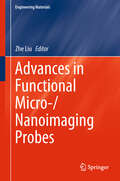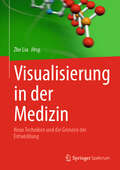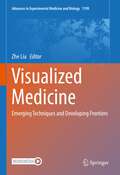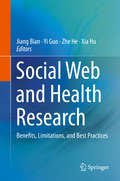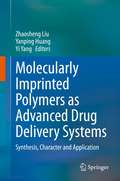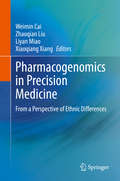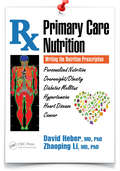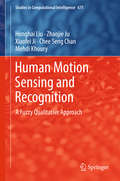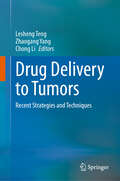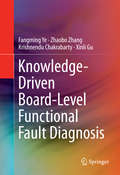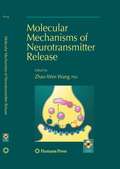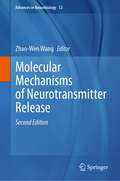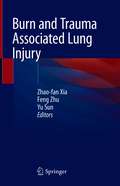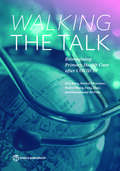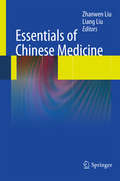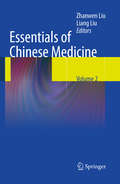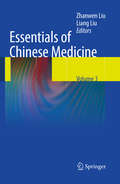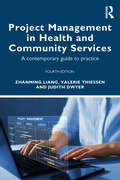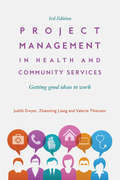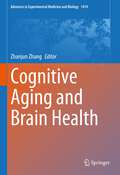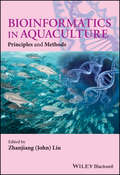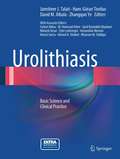- Table View
- List View
Advances in Functional Micro-/Nanoimaging Probes (Engineering Materials)
by Zhe LiuThis book highlights the latest advances in functional micro/nano imaging probes and their applications for biomedical imaging and therapy. Given the rapid emergence of transdisciplinary research and applications in materials, chemical probes and translational medicine in recent years, scientists in these areas are expected to keep up to date on the latest technologies and advances to promote comprehensive innovations. Addressing this need, the book presents recently introduced features, emerging techniques, and new strategies, complemented by detailed illustrations. Covering the status quo and offering an outlook on the future, it benefits all readers with an interest in functional materials, especially micro/nano imaging materials for biomedical imaging applications, providing them with both vital updates and inspiration for their own research.
Visualisierung in der Medizin: Neue Techniken und die Grenzen der Entwicklung
by Zhe LiuDieses Buch fasst die jüngsten Fortschritte in der visualisierten Medizin zusammen, sowohl hinsichtlich der grundlegenden Prinzipien als auch der Entwicklung neuer Techniken und deren Grenzen. Besonders in Kombination mit künstlicher Intelligenz (KI), medizinischen Bildgebungsverfahren und medizinischen Robotern wurden intelligente Medizintechnologien entwickelt und klinisch angewendet, um die Diagnose, Behandlung, Prognose und Datenanalyse von lebensbedrohlichen Krankheiten zu verbessern. Diese Philosophie revolutioniert umfassend die Behandlungsstrategie im Gesundheitswesen und wird die Präzisionsmedizin und Präzisionschirurgie weiter intuitiv erfassbar, intelligent analysierbar und präzise umsetzbar machen. Das Buch beinhaltet folgende Themen und fasst sie zusammen: Die hochmoderne Definition der visualisierten Medizin. Fortschrittliche Techniken und klinische Anwendungen der visualisierten Medizin im vergangenen Jahrzehnt. Neue Grenzen und brandneue Technologien, z.B. künstliche Intelligenz (KI), chirurgische Roboter, etc. Revolutionäre Auswirkungen auf Diagnose, Behandlung und Prognose von Krankheiten. Zukünftige Herausforderungen und Perspektiven.
Visualized Medicine: Emerging Techniques and Developing Frontiers (Advances in Experimental Medicine and Biology #1199)
by Zhe LiuThis book summarizes the recent advancements for visualized medicine in terms of fundamental principles, rapidly emerging techniques and developing frontiers. Especially with the combination of artificial intelligence (AI), medical imaging agents and medical robots, smart medical technologies have been innovated and applied to the clinical uses to serve the fatal human diseases diagnosis, treatment, prognosis and data analysis. This philosophy comprehensively revolutionizes the treatment strategy of human healthcare, and will enable precision medicine and precision surgery further intuitively detectable, smartly analyzable and accurately operational. This book will discuss and conclude: 1) state-of-the-art definition of visualized medicine; 2) advanced techniques and clinical applications of visualized medicine in the past decade; 3) novel frontiers and brand-new technologies, e.g. artificial intelligence (AI), surgical robots, etc. 4) revolutionary impacts on disease diagnosis, treatments and prognosis; 5) future challenges and perspectives.
Social Web and Health Research: Benefits, Limitations, and Best Practices
by Yi Guo Jiang Bian Zhe He Xia HuThis book presents state-of-the-art research methods, results, and applications in social media and health research. It aims to help readers better understand the different aspects of using social web platforms in health research. Throughout the chapters, the benefits, limitations, and best practices of using a variety of social web platforms in health research are discussed with concrete use cases. This is an ideal book for biomedical researchers, clinicians, and health consumers (including patients) who are interested in learning how social web platforms impact health and healthcare research.
Advanced State Space Methods for Neural and Clinical Data
by Zhe ChenThis authoritative work provides an in-depth treatment of state space methods, with a range of applications in neural and clinical data. Advanced and state-of-the-art research topics are detailed, including topics in state space analyses, maximum likelihood methods, variational Bayes, sequential Monte Carlo, Markov chain Monte Carlo, nonparametric Bayesian, and deep learning methods. Details are provided on practical applications in neural and clinical data, whether this is characterising time series data from neural spike trains recorded from the rat hippocampus, the primate motor cortex, or the human EEG, MEG or fMRI, or physiological measurements of heartbeats or blood pressures. With real-world case studies of neuroscience experiments and clinical data sets, and written by expert authors from across the field, this is an ideal resource for anyone working in neuroscience and physiological data analysis.
Molecularly Imprinted Polymers as Advanced Drug Delivery Systems: Synthesis, Character and Application
by Yi Yang Zhaosheng Liu Yanping HuangThis book summarizes the recent advancements for drug delivery systems (DDS) in terms of fundamental principles, rapidly emerging techniques and developing frontiers of molecular imprinting. Especially with the combination of enantioselective molecularly imprinted polymers and water compatible molecularly imprinted polymers, stimuli responsive imprinted DDS have been innovated and applied to dermal delivery, ophthalmic drugs and cancer treatment. This philosophy comprehensively revolutionizes the treatment strategy of human healthcare and provides the possibility to re-trigger in vivo an exhaust system after the complete release of the starting drug cargo, thus enabling precision medicine. To this end, the following unique features will be discussed and concluded: 1) State-of-the-art definition of MIP as drug delivery systems. 2) Advanced techniques and clinical applications of MIP as drug delivery systems in the past decade. 3) Novel frontiers and brand-new technologies, for example, drug delivery devices for zero-order sustained release and stimuli responsive imprinted DDS. 4) Revolutionary impact on dermal delivery, ophthalmic drugs and cancer treatment. 5) Future challenges and perspectives
Pharmacogenomics in Precision Medicine: From a Perspective of Ethnic Differences
by Weimin Cai Zhaoqian Liu Liyan Miao Xiaoqiang XiangThis book provides an introduction to the principles of pharmacogenomics and precision medicine, followed by the pharmacogenomics aspects of major therapeutic areas such as cardiovascular disease, cancer, organ transplantation, psychiatry, infection, antithrombotic drugs. It also includes genotyping technology and therapeutic drug monitoring in Pharmacogenomics; ethical, Legal and Regulatory Issues; cost-effectiveness of pharmacogenetics-guided treatment; application of pharmacogenomics in drug discovery and development and clinical Implementation of Pharmacogenomics for Personalized Precision Medicine. The contributors of Pharmacogenomics in Precision Medicine come from a team of experts, including professors from academic institutions and practitioner from hospital. It will give an in-depth overview of the current state of pharmacogenomics in drug therapy for all health care professionals and graduate students in the era of precision medicine.
Primary Care Nutrition: Writing the Nutrition Prescription
by David Heber Zhaoping LiThis book contains the necessary knowledge and tools to incorporate nutrition into primary care practice. As a practical matter, this effort is led by a dedicated primary care physician with the help of motivated registered dietitians, nurses, psychologists, physical therapists, and office staff whether within a known practice or by referral to the community. It is essential that the nutrition prescription provided by the physician be as efficient as possible. While many team members have superior knowledge in the areas of nutrition, exercise, and psychology, the health practitioner remains the focus of patient confidence in a therapy plan. Therefore, the endorsement of the plan rather than the implementation of the plan is the most important task of the physician. <P><P> This book proposes a significant change in attitude of primary health care providers in terms of the power of nutrition in prevention and treatment of common disease. It features detailed and referenced information on the role of nutrition in the most common conditions encountered in primary care practice. In the past, treatment focused primarily on drugs and surgery for the treatment of disease with nutrition as an afterthought. Advanced technologies and drugs are effective for the treatment of acute disease, but many of the most common diseases such as heart disease, diabetes, and cancer are not preventable with drugs and surgery. While there is mention of prevention of heart disease, this largely relates to the use of statins with some modest discussion of a healthy diet. Similarly, prevention of type 2 diabetes is the early introduction of metformin or intensive insulin therapy.
Primary Care Nutrition: Writing the Nutrition Prescription
by David Heber Zhaoping LiThis book contains the necessary knowledge and tools to incorporate nutrition into primary care practice. As a practical matter, this effort is led by a dedicated primary care physician with the help of motivated registered dietitians, nurses, psychologists, physical therapists, and office staff whether within a known practice or by referral to the community. It is essential that the nutrition prescription provided by the physician be as efficient as possible. While many team members have superior knowledge in the areas of nutrition, exercise, and psychology, the health practitioner remains the focus of patient confidence in a therapy plan. Therefore, the endorsement of the plan rather than the implementation of the plan is the most important task of the physician. This book proposes a significant change in attitude of primary health care providers in terms of the power of nutrition in prevention and treatment of common disease. It features detailed and referenced information on the role of nutrition in the most common conditions encountered in primary care practice. In the past, treatment focused primarily on drugs and surgery for the treatment of disease with nutrition as an afterthought. Advanced technologies and drugs are effective for the treatment of acute disease, but many of the most common diseases such as heart disease, diabetes, and cancer are not preventable with drugs and surgery. While there is mention of prevention of heart disease, this largely relates to the use of statins with some modest discussion of a healthy diet. Similarly, prevention of type 2 diabetes is the early introduction of metformin or intensive insulin therapy.
Human Motion Sensing and Recognition: A Fuzzy Qualitative Approach (Studies in Computational Intelligence #675)
by Honghai Liu Zhaojie Ju Xiaofei Ji Chee Seng Chan Mehdi KhouryThis book introduces readers to the latest exciting advances in human motion sensing and recognition, from the theoretical development of fuzzy approaches to their applications. The topics covered include human motion recognition in 2D and 3D, hand motion analysis with contact sensors, and vision-based view-invariant motion recognition, especially from the perspective of Fuzzy Qualitative techniques.With the rapid development of technologies in microelectronics, computers, networks, and robotics over the last decade, increasing attention has been focused on human motion sensing and recognition in many emerging and active disciplines where human motions need to be automatically tracked, analyzed or understood, such as smart surveillance, intelligent human-computer interaction, robot motion learning, and interactive gaming. Current challenges mainly stem from the dynamic environment, data multi-modality, uncertain sensory information, and real-time issues.These techniques are shown to effectively address the above challenges by bridging the gap between symbolic cognitive functions and numerical sensing & control tasks in intelligent systems. The book not only serves as a valuable reference source for researchers and professionals in the fields of computer vision and robotics, but will also benefit practitioners and graduates/postgraduates seeking advanced information on fuzzy techniques and their applications in motion analysis.
Advances in Statistical Bioinformatics: Models and Integrative Inference for High-Throughput Data
by Kim-Anh Do Zhaohui Steve Qin Marina VannucciProviding genome-informed personalized treatment is a goal of modern medicine. Identifying new translational targets in nucleic acid characterizations is an important step toward that goal. The information tsunami produced by such genome-scale investigations is stimulating parallel developments in statistical methodology and inference, analytical frameworks, and computational tools. Within the context of genomic medicine and with a strong focus on cancer research, this book describes the integration of high-throughput bioinformatics data from multiple platforms to inform our understanding of the functional consequences of genomic alterations. This includes rigorous and scalable methods for simultaneously handling diverse data types such as gene expression array, miRNA, copy number, methylation, and next-generation sequencing data. This material is written for statisticians who are interested in modeling and analyzing high-throughput data. Chapters by experts in the field offer a thorough introduction to the biological and technical principles behind multiplatform high-throughput experimentation.
Drug Delivery to Tumors: Recent Strategies and Techniques
by Chong Li Lesheng Teng Zhaogang YangThis book aims to present the latest research on drug delivery systems. It summarizes emerging drug delivery strategies and new technologies for cancer treatment, viewed through the lens of cancer pathology. Topics include immunotherapy strategies, biomimetic drug delivery strategies, live cell drug delivery strategies, nanocrystal technology, and 3D printing technology. The book is intended for researchers, R&D engineers, and graduate students in the pharmaceutical field. Additionally, it is expected to inspire collaboration among experts from different disciplines to advance the development of drug delivery systems.
Knowledge-Driven Board-Level Functional Fault Diagnosis
by Krishnendu Chakrabarty Fangming Ye Zhaobo Zhang Xinli GuThis book provides a comprehensive set of characterization, prediction, optimization, evaluation, and evolution techniques for a diagnosis system for fault isolation in large electronic systems. Readers with a background in electronics design or system engineering can use this book as a reference to derive insightful knowledge from data analysis and use this knowledge as guidance for designing reasoning-based diagnosis systems. Moreover, readers with a background in statistics or data analytics can use this book as a practical case study for adapting data mining and machine learning techniques to electronic system design and diagnosis. This book identifies the key challenges in reasoning-based, board-level diagnosis system design and presents the solutions and corresponding results that have emerged from leading-edge research in this domain. It covers topics ranging from highly accurate fault isolation, adaptive fault isolation, diagnosis-system robustness assessment, to system performance analysis and evaluation, knowledge discovery and knowledge transfer. With its emphasis on the above topics, the book provides an in-depth and broad view of reasoning-based fault diagnosis system design. * Explains and applies optimized techniques from the machine-learning domain to solve the fault diagnosis problem in the realm of electronic system design and manufacturing; * Demonstrates techniques based on industrial data and feedback from an actual manufacturing li≠ * Discusses practical problems, including diagnosis accuracy, diagnosis time cost, evaluation of diagnosis system, handling of missing syndromes in diagnosis, and need for fast diagnosis-system development.
Molecular Mechanisms of Neurotransmitter Release
by Zhao-Wen WangWithin the complex neuronal network of the nervous system, neuron-to-neuron communication occurs mainly through chemical synapses, where the presynaptic nerve terminal releases neurotransmitters which control the function of postsynaptic neurons by acting on postsynaptic receptors. Recent decades have brought ground-breaking new developments and a wealth of knowledge to this field. In 'Molecular Mechanisms of Neurotransmitter Release', leading experts provide concise, up-to-date information on all major molecular mechanisms involved, with complete background information and figures and diagrams to further elucidate key concepts or experiments. Comprehensive and cutting-edge, 'Molecular Mechanisms of Neurotransmitter Release' is sure to provide a learning tool for neuroscience students, a solid reference for neuroscientists, and a source of knowledge for all those who have a general interest in the ever-evolving field of neuroscience
Molecular Mechanisms of Neurotransmitter Release (Advances in Neurobiology #33)
by Zhao-Wen WangNeurons communicate with each other by releasing neurotransmitters. This book provides comprehensive coverage of the molecular mechanisms involved in neurotransmitter release. The topics covered in the book range from the architecture and cytomatrix proteins of presynaptic sites, to the modes of synaptic vesicle exocytosis (full-collapse and kiss-and-run), and from the key molecules mediating synaptic vesicle fusion (SNAREs) to those that closely interact with them (UNC-13/Munc13, UNC-18/Munc18, tomosyn, and complexins). The book also delves into the calcium sensors of synaptic vesicle fusion (synaptotagmins and Doc2s), the sources of calcium that trigger synaptic exocytosis (voltage-gated calcium channels and ryanodine receptors), and the regulation of neurotransmitter release by potassium channels, cell adhesion molecules, lipids, aryl hydrocarbon receptor-interacting protein (AIP), presenilins, and calstabins. To aid in understanding and illustrate key concepts, the book includes sufficient background information and a wealth of illustrations and diagrams. The new edition includes major updates to previous chapters, as well as several new chapters that reflect the recent advances in the field. Comprehensive and cutting-edge, Molecular Mechanisms of Neurotransmitter Release, 2nd edition, is a valuable learning resource for neuroscience students and a solid reference for neuroscientists.
Burn and Trauma Associated Lung Injury
by Yu Sun Feng Zhu Zhao-Fan XiaThis book provides in-depth analysis and guidance in the clinical diagnosis and treatment, and development of new treatments with clinical applied prospect of burn and trauma associated lung injury. It includes study on the pathological change of burn and trauma associated lung injury such as inhalation injury, lung blast injury, pulmonary barotrauma, delayed hemopneumothorax, lung injury associated sepsis, ventilator-induced lung injury and ischemia-reperfusion lung injury. It is also compiled with many clinical typical cases, full data and series of pictures.It also aims at bringing more clinicians’ attention to burn-/trauma-induced lung injury, making them familiar with the relevant theories and clinical diagnose; guiding the treatment of burn and trauma associated lung injury and improving the prognosis and life quality of patients; stimulating more clinicians and researchers to further explore the pathological mechanism and new treatments of burn and trauma associated lung injury. It persists in combining theory and practice, and highlights practical application to reflect the theoretical value. It is very suitable for the medical teaching and can also be used as a reference book for medical doctoral students, postgraduates, and medical trainees receiving continuing education from critical care medicine, burn & trauma surgery, and emergency medicine.
Walking the Talk: Reimagining Primary Health Care after COVID-19
by Enis BarıŠŸ Rachel Silverman Huihui Wang ZhaoAlmost half a century ago, policy leaders issued the Declaration of Alma Ata and embraced the promise of health for all through primary health care (PHC). That vision has inspired generations. Countries throughout the world—rich and poor—have struggled to build health systems anchored in strong PHC where they were needed most. The world has waited long enough for high-performing PHC to become more than an aspiration; it is now time to deliver. The COVID-19 (Coronavirus) pandemic has facilitated the reckoning for that shared failure—but it has also created a once-in-a-generation opportunity for transformational health system changes. The pandemic has shown policy makers and ordinary citizens why health systems matter and what happens when they fail. Bold reforms now can prepare health systems for future crises and bring goals such as universal health coverage within reach. PHC holds the key to these transformations. To fulfill that promise, however, the walk has to finally match the talk. Walking the Talk: Reimagining Primary Health Care after COVID-19 outlines how to get there. It charts an agenda to reimagined, fit-for-purpose PHC. It asks three questions about health systems reform built around PHC: Why? What? How? The characteristics of high-performing PHC are precisely those that are most critical for managing the pressures coming to bear on health systems in the post-COVID world. The challenges include future outbreaks and other emergent threats, as well as long-term structural trends that are reshaping the environments in which systems operate in noncrisis times. Walking the Talk highlights three sets of megatrends that will increasingly affect health systems in the coming decades: • Demographic and epidemiological shifts • Changes in technology • Citizens’ evolving expectations for health care. Reimagined PHC systems will be equipped through optimized system design, financing, and delivery to ensure high-quality services, care to address patients’ needs, fairness and accountability, and resilient systems.
Essentials of Chinese Medicine, Volume 1
by Liang Liu Zhanwen LiuThe modern medical model is gradually shifting from one of biomedicine to one that integrates practices from the physiological, psychological, sociological and medical fields. This growing recognition that people, the environment, ecological conditions and society are all aspects of a united whole has given rise to an emergence of alternative medicine and therapies, many of which are borrowed from traditional Chinese medicine.<P><P> Essentials of Chinese Medicine systematically introduces the basic theories, diagnostic methods, therapeutic practices, and the principles of health preservation and rehabilitation of the Chinese medical tradition. The basic theories and methods of acupuncture and moxibustion are explained, and a range of Chinese herbs are illustrated. The textbooks also introduces 84 Chinese herbal formulas and 6 associated formulas commonly used in clinical practice. Furthermore, it elucidates treatments of commonly and frequently encountered diseases in internal medicine, surgery, gynecology, pediatrics, ophthalmology and otorhinolaryngology.<P><P> With a strong emphasis on the fundamental principles of Chinese Medicine, this three-volume set provides concise and systematic content that is suitable for both teaching and self-study.
Essentials of Chinese Medicine, Volume 2
by Liang Liu Zhanwen LiuThe modern medical model is gradually shifting from one of biomedicine to one that integrates practices from the physiological, psychological, sociological and medical fields. This growing recognition that people, the environment, ecological conditions and society are all aspects of a united whole has given rise to an emergence of alternative medicine and therapies, many of which are borrowed from traditional Chinese medicine.<P><P> Volume Two presents the therapeutic methods of Chinese Medicine, including the basic methods and theories of acupuncture and moxibustion. 84 Chinese herbal formulas and 6 associated formulas commonly used in clinical practice are explained and illustrated, providing the reader with a thorough introduction to the use of herbs in Chinese Medicine.
Essentials of Chinese Medicine, Volume 3
by Liang Liu Zhanwen LiuThe modern medical model is gradually shifting from one of biomedicine to one that integrates practices from the physiological, psychological, sociological and medical fields. This growing recognition that people, the environment, ecological conditions and society are all aspects of a united whole has given rise to an emergence of alternative medicine and therapies, many of which are borrowed from traditional Chinese medicine.<P><P> Volume Three elucidates the treatments of Chinese Medicine for commonly encountered diseases in internal medicine, surgery, gynecology, pediatrics, ophthalmology and otorhinolaryngology. The authors present supplementary case studies, which helpfully augment the reader’s grasp of the traditional Chinese medical approach to these conditions.
Project Management in Health and Community Services: A contemporary guide to practice
by Judith Dwyer Valerie Thiessen Zhanming LiangThe new edition of this best-selling text presents the tools and techniques for effectively managing every kind of development and change in health and community services, while also balancing the needs of a range of stakeholders. It offers practical, problem-solving strategies based on real-life scenarios.A core competency for health and community service practitioners internationally, project management is a key challenge for both new and existing staff. This practitioner’s guide uses project stories and examples to illustrate the core challenges that practitioners may face, including managing the project life cycle, project planning, execution and evaluation, risk management, handling change and building effective teams. Alongside new interviews with staff working across a range of sectors, this edition includes new content on career development and pathways as well as the growing integration of project methods into general management, and the impact of broader changes like digital innovation and transformation.Written by highly experienced authors, and underpinned by the latest research, this enlightening and practical guide is an essential resource for anyone studying or working in health and community services.
Project Management in Health and Community Services: Getting good ideas to work
by Judith Dwyer Valerie Thiessen Zhanming LiangProject management is recognised as a core competency across health and community services environments, yet it can be challenging for new project staff and practitioners to balance the needs of stakeholders and ensure the best outcome for everyone involved.This wholly revised edition of Project Management in Health and Community Services presents the tools and techniques for effective practice, offering practical problem-solving strategies for managing projects based on real-life scenarios. The expert authors use case studies and examples from the field to illustrate topics such as the project life cycle, project planning, execution and evaluation, risk management, handling change and building effective teams. This edition also features a new chapter on the importance of incorporating evaluation into project design and implementation, and how evaluation can impact on future project design and development.Written by highly experienced authors and underpinned by the latest research, this is an essential resource for anyone studying or working in health and community services.
Cognitive Aging and Brain Health (Advances in Experimental Medicine and Biology #1419)
by Zhanjun ZhangThis book reviews the research trends of cognitive aging and brain health from full-scale. It not only contains cognitive aging’s neurophysiological mechanism, clinical research and intervention measures, but also covers cognitive aging’s social psychological mechanism, such as the relation between old people’s motion, socioeconomic status and the cognitive aging. Through decades of research and practice, the views towards the cognitive aging process havebeen transferred from coping with cognitive decline to promoting cognitive ability. This book provides with the latest research findings and in-depth opinions of the cognitive aging and brain health, assisting researchers to grasp the theories, practice and trends of this field, and guide health-care workers to carry out the treatment and nursing for the aged.
Bioinformatics in Aquaculture: Principles and Methods
by Zhanjiang John LiuBioinformatics derives knowledge from computer analysis of biological data. In particular, genomic and transcriptomic datasets are processed, analysed and, whenever possible, associated with experimental results from various sources, to draw structural, organizational, and functional information relevant to biology. Research in bioinformatics includes method development for storage, retrieval, and analysis of the data. Bioinformatics in Aquaculture provides the most up to date reviews of next generation sequencing technologies, their applications in aquaculture, and principles and methodologies for the analysis of genomic and transcriptomic large datasets using bioinformatic methods, algorithm, and databases. The book is unique in providing guidance for the best software packages suitable for various analysis, providing detailed examples of using bioinformatic software and command lines in the context of real world experiments. This book is a vital tool for all those working in genomics, molecular biology, biochemistry and genetics related to aquaculture, and computational and biological sciences.
Urolithiasis
by Zhangqun Ye Jamsheer J. Talati Hans-Goran Tiselius David M. AlbalaUrolithiasis: Basic Science and Clinical Practice is a comprehensive text that assists urologists in defining the best choice of treatment for each case through a balanced presentation of underlying science, diagnostic methods and practical tips, with additional discussions on educational issues, costs and management of resources. This user-friendly practical resource is replete with full-color illustrations and radiographs, covering all aspects of stone disease, and offering perspectives from Europe, the Americas, China, South Asia, Africa, and Australia. Topics include the biochemical and physiological basis of stone formation, treatment options, complications, assessment of techniques and technologies available, and guidelines on the prevention of stone recurrence. Urolithiasis: Basic Science and Clinical Practice is the definitive text on stone disease and is a must read for young consultants starting a new practice, and urologists in residence and training.
